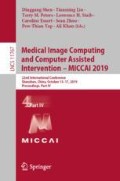Abstract
Localization of focal vascular lesions on brain MRI is an important component of research on the etiology of neurological disorders. However, manual annotation of lesions can be challenging, time-consuming and subject to observer bias. Automated detection methods often need voxel-wise annotations for training. We propose a novel approach for automated lesion detection that can be trained on scans only annotated with a dot per lesion instead of a full segmentation. From the dot annotations and their corresponding intensity images we compute various distance maps (DMs), indicating the distance to a lesion based on spatial distance, intensity distance, or both. We train a fully convolutional neural network (FCN) to predict these DMs for unseen intensity images. The local optima in the predicted DMs are expected to correspond to lesion locations. We show the potential of this approach to detect enlarged perivascular spaces in white matter on a large brain MRI dataset with an independent test set of 1000 scans. Our method matches the intra-rater performance of the expert rater that was computed on an independent set. We compare the different types of distance maps, showing that incorporating intensity information in the distance maps used to train an FCN greatly improves performance.
K.M.H. van Wijnen and F. Dubost—Both authors contributed equally to this work.
Access this chapter
Tax calculation will be finalised at checkout
Purchases are for personal use only
Notes
- 1.
Our code for computing 2D as well as 3D distance maps is available at https://github.com/kimvwijnen/geodesic_distance_transform.
References
Adams, H.H.H., et al.: Rating method for dilated Virchow-Robin spaces on magnetic resonance imaging. Stroke 44, 1732–1735 (2013)
Adams, H.H., et al.: A priori collaboration in population imaging: the uniform neuro-imaging of Virchow-Robin spaces enlargement consortium. Alzheimer’s Dement. Diagn. Assess. Dis. Monit. 1(4), 513–520 (2015)
Ballerini, L., et al.: Perivascular spaces segmentation in brain MRI using optimal 3D filtering. Sci. Rep. 8(1), 2132 (2018)
Boespflug, E.L., Schwartz, D.L., Lahna, D., Pollock, J., Iliff, J.J., Kaye, J.A., et al.: MR imagingbased multimodal autoidentification of perivascular spaces (mMAPS): automated morphologic segmentation of enlarged perivascular spaces at clinical field strength. Radiology 286(2), 632–642 (2018)
Brosch, T., Tang, L.Y.W., Yoo, Y., Li, D.K.B., Traboulsee, A., Tam, R.: Deep 3D convolutional encoder networks with shortcuts for multiscale feature integration applied to multiple sclerosis lesion segmentation. IEEE T-MI 35(5), 1229–1239 (2016)
Charidimou, A., et al.: Enlarged perivascular spaces as a marker of underlying arteriopathy in intracerebral haemorrhage: a multicentre MRI cohort study. J. Neurol. Neurosurg. Psychiatry 84(6), 624–629 (2013)
Desikan, R.S., Ségonne, F., Fischl, B., Quinn, B.T., Dickerson, B.C., Blacker, D., et al.: An automated labeling system for subdividing the human cerebral cortex on MRI scans into gyral based regions of interest. NeuroImage 31(3), 968–980 (2006)
Dou, Q., Chen, H., Yu, L., Zhao, L., Qin, J., Wang, D., et al.: Automatic detection of cerebral microbleeds from MR images via 3D convolutional neural networks. TMI 35(5), 1182–1195 (2016)
Dubost, F., et al.: GP-Unet: lesion detection from weak labels with a 3D regression network. In: Descoteaux, M., Maier-Hein, L., Franz, A., Jannin, P., Collins, D.L., Duchesne, S. (eds.) MICCAI 2017. LNCS, vol. 10435, pp. 214–221. Springer, Cham (2017). https://doi.org/10.1007/978-3-319-66179-7_25
Dubost, F., et al.: Enlarged perivascular spaces in brain MRI: automated quantification in four regions. NeuroImage 185, 534–544 (2019)
Ghafoorian, M., et al.: Deep multi-scale location-aware 3D convolutional neural networks for automated detection of lacunes of presumed vascular origin. NeuroImage: Clin. 14, 391–399 (2017)
Ikram, M.A., et al.: The rotterdam scan study: design update 2016 and main findings. Eur. J. Epidemiol. 30(12), 1299–1315 (2015)
Lian, C., et al.: Multi-channel multi-scale fully convolutional network for 3D perivascular spaces segmentation in 7T MR images. Med. Image Anal. 46, 106–117 (2018)
Meyer, M.I., Galdran, A., Mendonça, A.M., Campilho, A.: A pixel-wise distance regression approach for joint retinal optical disc and fovea detection. In: Frangi, A.F., Schnabel, J.A., Davatzikos, C., Alberola-López, C., Fichtinger, G. (eds.) MICCAI 2018. LNCS, vol. 11071, pp. 39–47. Springer, Cham (2018). https://doi.org/10.1007/978-3-030-00934-2_5
Qi, H., Collins, S., Noble, J.A.: Automatic lacunae localization in placental ultrasound images via layer aggregation. In: Frangi, A.F., Schnabel, J.A., Davatzikos, C., Alberola-López, C., Fichtinger, G. (eds.) MICCAI 2018. LNCS, vol. 11071, pp. 921–929. Springer, Cham (2018). https://doi.org/10.1007/978-3-030-00934-2_102
Ronneberger, O., Fischer, P., Brox, T.: U-Net: convolutional networks for biomedical image segmentation. In: Navab, N., Hornegger, J., Wells, W.M., Frangi, A.F. (eds.) MICCAI 2015. LNCS, vol. 9351, pp. 234–241. Springer, Cham (2015). https://doi.org/10.1007/978-3-319-24574-4_28
Toivanen, P.J.: New geodosic distance transforms for gray-scale images. Pattern Recogn. Lett. 17(5), 437–450 (1996)
Xie, Y., Xing, F., Shi, X., Kong, X., Su, H., Yang, L.: Efficient and robust cell detection: a structured regression approach. Med. Image Anal. 44, 245–254 (2018)
Acknowledgments
This research is part of the research project Deep Learning for Medical Image Analysis (DLMedIA) with project number P15-26, funded by the Dutch Technology Foundation STW (part of the Netherlands Organisation for Scientific Research (NWO), which is partly funded by the Ministry of Economic Affairs), and with co-financing by Quantib. This research was also funded by the Netherlands Organisation for Health Research and Development (ZonMw), Project 104003005. Part of this work was carried out on the Dutch national e-infrastructure with the support of SURF Cooperative and on a Quadro P6000 donated by the NVIDIA Corporation.
Author information
Authors and Affiliations
Corresponding author
Editor information
Editors and Affiliations
Rights and permissions
Copyright information
© 2019 Springer Nature Switzerland AG
About this paper
Cite this paper
van Wijnen, K.M.H. et al. (2019). Automated Lesion Detection by Regressing Intensity-Based Distance with a Neural Network. In: Shen, D., et al. Medical Image Computing and Computer Assisted Intervention – MICCAI 2019. MICCAI 2019. Lecture Notes in Computer Science(), vol 11767. Springer, Cham. https://doi.org/10.1007/978-3-030-32251-9_26
Download citation
DOI: https://doi.org/10.1007/978-3-030-32251-9_26
Published:
Publisher Name: Springer, Cham
Print ISBN: 978-3-030-32250-2
Online ISBN: 978-3-030-32251-9
eBook Packages: Computer ScienceComputer Science (R0)


